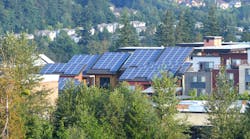Is community solar, which has long been viewed by some industry stakeholders as the black sheep of the solar movement, finally getting a new image? In many parts of the country nothing raises the hackles of utility and regulatory executives more than community solar projects, some of which may be perceived to skirt the franchise territory regulatory framework we’ve used for over 100 years.
Nearly all utilities have embraced solar as a viable renewable alternative and want to own and dispatch their own solar projects. Further, they recognize it is not good business to fight the flood of customer-owned residential solar projects, which when properly sited, can actually provide some benefits to the utility. For some utilities, dealing with third party-owned independent solar projects in their own service territories is an uncomfortable exercise of holding one’s nose and allowing (or participating in) a transaction that ultimately could be required by state or federal law. Other utilities not only make a business of developing solar projects outside of their own service territories, but also have recognized the value of contracting with third-party developers in their territories for solar capacity at very favorable rates.
Enter community solar projects, which may deliver power directly to the utility distribution system but entail some form of transaction that mimics a power sale directly or indirectly with residential utility customers. There was a time when essentially all utilities and regulators would voraciously fight such projects. Today, however, we are seeing some growth and greater attention paid to community solar projects. According to the Smart Electric Power Alliance (SEPA), community solar projects doubled between 2016 and 2017. While the sheer magnitude of this growth is minimal, about 1% of the U.S. solar market, the participant makeup is telling. At present, 228 utilities in 36 states have active community solar programs. Of these entities, 160 are cooperatives, 37 are public power utilities and 31 are investor-owned utilities.
Is the community-focused mandate of cooperatives and public power companies the reason for the spike in community solar projects? Probably not. SEPA’s research shows that 239 MW of the total installed capacity is administered by utilities, while private developers account for 495 MW or about 67% of the installed community solar capacity. So what drove the rapid growth in community solar last year and is the pace likely to continue?
SEPA believes the factors behind the growth include the decline in solar cost, greater customer awareness of the community solar business model and probably foremost, the expanding number of states with some form of shared solar policy. Presently, 17 states have such policies and nine are considering new or expanded rules. The policies differ regarding significant details such as allowance for third-party ownership, the allowable project scale and the bill credit rate for participating customers.
In addition to changing state-shared solar rules, SEPA believes the future growth of community solar depends on what states do with their renewable portfolio mandates once current goals are met and the extent to which utilities decide to develop their own renewable projects, which could obviate the need for customers to look elsewhere for green energy. Some analysts believe the new solar import tariffs will negatively impact residential solar, but may actually benefit larger projects like community solar and utility owned projects which have greater economies of scale. Economies of scale also apply to development, construction and financing of community projects and the increase in state community solar policies has a great impact on acceptance by the financial community. One might argue that community solar is indeed shedding its old image.


